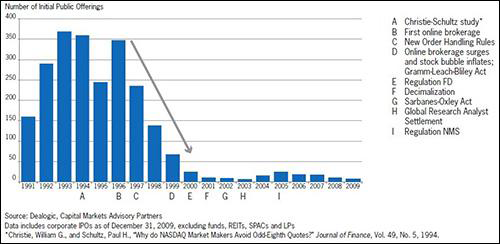By Pam Martens: December 5, 2012
On Monday, the SEC announced it was going to study decimalization — that’s the pricing of stocks in pennies instead of using the historic practice of pricing stocks in fractions. What the SEC really means is that it is going to study the death of IPOs on U.S. stock exchanges, how that is contributing to the death of jobs in the economy, and how all of that may rest at the doorstep of high frequency traders who remain in business only because of the pricing of stocks in pennies. If stocks were priced in fractions, it would be far too expensive for high frequency traders to exist.
There are two words to explain this sudden exuberance by outgoing SEC Chair Mary Schapiro. Those two words are: Grant Thornton. The big accounting firm has been making waves with a comprehensive study on the sickly listing of new companies on U.S. exchanges, i.e., IPOs or Initial Public Offerings. One of the key culprits says Grant Thornton is high frequency trading.
It should have been very easy for both Congress and the SEC to figure this out using common sense. If you are an entrepreneur and have built a solid business that is making slow but steady progress, you have two options: continue on the path that is clearly working or list your stock on a public exchange and risk the following: a flash crash, a huge embarrassment on the day you go public as has happened with other high profile listings of late, run the risk there is no interest in the market for your stock and end up humiliating yourself and your family by being delisted and ending up on the pink sheets (a marketplace for delisted or penny stocks).
The majority of trading on exchanges now comes from high frequency trading. What these traders care about is penny pricing – so they can get in and out cheaply; big cap companies that have lots of liquidity – so they can get in and out cheaply. No flack from the SEC – so they can get in and out cheaply.
What the high frequency traders do not care about is the dying IPO market, the U.S. job market, or the competitive future of the United States.
The full SEC press release is printed below.
SEC Staff to Host Decimalization Roundtable
Washington, D.C., Dec. 3, 2012 — The Securities and Exchange Commission today announced that its staff will host a roundtable early next year to discuss the impact of decimal-based stock trading on small and mid-sized companies, market professionals, investors, and U.S. securities markets.
The roundtable will be held on Feb. 5 at the SEC’s Washington, D.C., headquarters, and will be open to the public and webcast live on the SEC’s website. Information on the agenda and participants will be issued shortly.
U.S. stock markets adopted decimal pricing increments in place of fractions in 2001, in part to address concerns that the U.S. was at a competitive disadvantage to markets outside the U.S. using decimal pricing. Proponents of decimal pricing also pointed to evidence of artificially wide spreads — the difference between the price to buy and sell a stock — with fractional pricing, which might benefit market makers at the expense of investors. Since the advent of decimalization, however, various parties have raised concerns that its adoption may be detrimental to small and mid-sized companies.
The Jumpstart Our Business Startups Act, or JOBS Act, enacted in April, directed the Commission to conduct a study of the effects of decimalization on initial public offerings (IPOs) and on small and middle-capitalization companies. In its Report to Congress on Decimalization, the SEC staff recommended that the Commission solicit the views of investors, companies, market professionals, academics, and other interested parties on decimalization generally, its effects on IPOs and on trading and liquidity for small and mid-cap companies, and what, if any, changes should be considered. The roundtable will provide a forum to discuss these issues and explore specific recommendations on structuring pilot programs to gather additional data and analysis on these issues.


